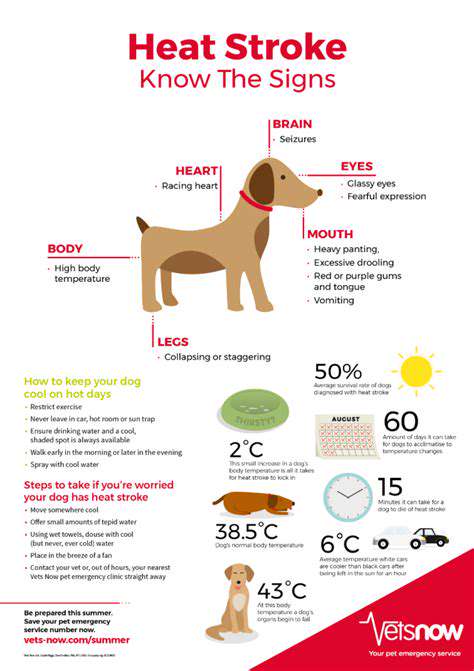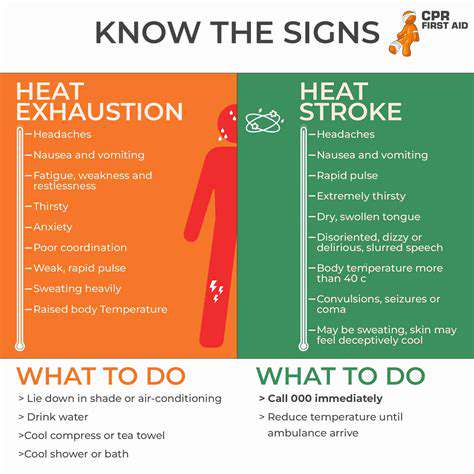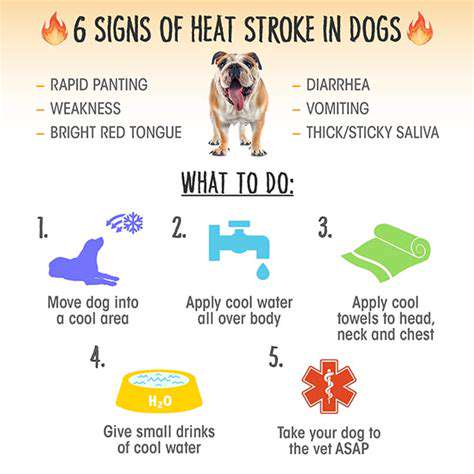Preventing Heatstroke in Dogs: Essential Tips for Pet Owners
Recognizing the Symptoms of Heatstroke in Dogs

Understanding Heatstroke in Dogs
Heatstroke occurs when a dog’s body temperature rises significantly above the normal range, leading to severe health risks. Quick recognition and intervention are crucial to preventing permanent damage or even death.
Typically, heatstroke happens when dogs are left in hot environments without proper ventilation or water. Owners should be vigilant, especially during the summer months or in warmer climates.
Common Symptoms to Look Out For
Recognizing the symptoms of heatstroke can save your dog's life. Some of the most common signs include excessive panting, drooling, and weakness.
If you notice your dog exhibiting these symptoms, it is essential to act quickly. Elevated heart rate, disorientation, and even vomiting are also critical indicators of heat distress.
Immediate Actions to Take
If you suspect your dog is suffering from heatstroke, the first step is to move them to a cooler area. Apply cool (not cold) water to their body to help bring down their temperature.
Additionally, offer your dog water to drink, but do not force it if they're too lethargic. Always monitor your pet closely until they show signs of recovery.
Preventative Measures for Hot Weather
Limit exercise on hot days and try to schedule walks during the morning or evening when temperatures are cooler. Being proactive can significantly reduce the risk of heatstroke in your pet.
When to Seek Veterinary Help
If your dog's symptoms persist or worsen despite treatment at home, it’s critical to seek veterinary care. Professional treatment may be necessary to ensure your dog’s safety and recovery.
Keep in mind that even if they seem to recover, there could be lasting effects. Regular check-ups and monitoring are essential for the health of any dog that has experienced heatstroke.
Understanding Factors Leading to Heatstroke

Environmental Conditions
Heatstroke often occurs during warm weather, especially when temperatures rise above 85°F. Dogs are particularly vulnerable to heat-related illnesses in high humidity. This is because humidity prevents effective cooling through panting. Furthermore, dogs left in closed vehicles without proper ventilation face an even greater risk. Always be aware of the environment when taking your dog outdoors during hot months.
Shade is crucial when your dog is outside. Provide plenty of shaded areas for your dog to find relief from the sun. This can include trees or umbrellas that block direct sunlight. Remember that even on seemingly mild days, the sun's rays can be intense and damaging. Keep an eye on the temperature and humidity levels in your area.
Different surfaces can absorb heat and contribute to overheating. Concrete and asphalt can become extremely hot, which can burn your dog's paw pads and cause heat stress. It’s important to touch the ground with your hand to gauge the temperature. Walking your dog during the cooler parts of the day, such as early morning or late evening, is advisable. Planning your walk around cooler times can help prevent overheating.
Be mindful of how long your dog is exposed to outdoor conditions. Even a brief time in the sun can lead to heat-related problems, especially for brachycephalic (short-nosed) breeds. These breeds, such as Bulldogs and Pugs, are particularly susceptible to breathing problems in hot weather. Always limit outdoor playtime when temperatures soar. Regular breaks in a cool setting can help maintain their body temperature.
Signs and Symptoms of Heatstroke
Recognizing the signs of heatstroke in dogs is vital for prompt action. Early symptoms may include excessive panting and drooling. As the condition worsens, dogs may display signs of lethargy or weakness. If your dog seems disoriented or collapses, immediate veterinary attention is necessary. These symptoms can escalate rapidly, underscoring the need for vigilance.
An increased heart rate is another telltale sign of heatstroke. Dogs may also exhibit a bright red or pale tongue and gums, indicating distress. It’s important to monitor their breathing; rapid and labored breathing are alarming indicators. Know your dog's typical behavior to better identify any troubling changes. Observations can lead to timely interventions that may save your dog’s life.
Cooling down an overheated dog is critical. If you suspect heatstroke, move your dog to a shaded or air-conditioned area immediately. You can apply cool, wet cloths to their body, focusing on the neck, armpits, and groin. Avoid using ice-cold water as it can cause shock. Instead, let your dog drink small amounts of cool water to rehydrate properly.
After stabilizing your dog, a trip to the veterinarian is essential to evaluate their condition. Some effects of heatstroke can be delayed, so a health check is a prudent step. Blood tests may be necessary to assess organ function. Understanding the severity of the situation can lead to a better outcome for your pet. Always err on the side of caution when your dog shows signs of heat stress.
Preventative Measures for Pet Owners
One of the best ways to prevent heatstroke is proper hydration. Ensure your dog has access to fresh, cool water at all times, especially on warm days. Consider providing portable water bowls for outings to encourage drinking. Keeping your dog hydrated significantly lowers the chances of overheating. A well-hydrated dog is a healthier and happier dog.
Limit outdoor activities during peak temperatures. Scheduling walks and playtime during the cooler morning or evening hours can make a difference. This reduces stress on your dog's body and helps prevent potential heat-related issues. Provide lighter exercise during the hottest parts of the day to keep energy levels optimal. Monitoring the weather forecast is a proactive approach to ensure your dog’s safety.
Invest in doggie gear designed to keep pets cool. Cooling vests and bandanas can help regulate body temperature. You can also provide a kiddie pool for your dog to splash around in during the summer months. These activities make fun, safe alternatives to strenuous exercise. Providing your dog with various cooling options can enhance their wellbeing.
Regular grooming also contributes to your dog’s ability to stay cool. A well-groomed coat can help with temperature regulation. While shaving may seem like a good idea, consult your veterinarian first; some coats offer protective qualities against heat. Brushing out loose fur can prevent overheating and improve comfort. Your dog’s appearance and health benefit from consistent grooming practices.
What to Do if Your Dog Displays Symptoms
If you suspect your dog is suffering from heatstroke, act fast. Move your dog to a cool environment immediately. Try to lower their body temperature gradually; this is key to preventing serious complications. Use cool water to wet their body while seeking veterinary attention. Every second counts when your dog is in distress from heat exposure.
Monitor your dog’s vital signs while you wait for help. Check their pulse and breathing rates, and be aware of any changes in their condition. Providing your vet with this information can be crucial for treatment decisions. Remember, heatstroke can cause long-term damage, so fast action is non-negotiable. Your dog’s overall health may depend on how quickly you respond.
If veterinary help is delayed, consider using cool towels and fans to help your dog recover slowly. Avoid strict cold treatments as it may cause further complications. Always focus on gradual cooling to bring the body temperature down effectively. Assess their energy levels and be prepared to provide supportive care as instructed by professionals. Knowledge is vital during a crisis; being prepared can make a definitive difference.
Educate everyone in your household about heat-related emergencies. Ensure that all family members understand the importance of recognizing symptoms and responding effectively. Building a culture of care helps protect your dog and provides assurance during difficult times. Sharing this knowledge with pet sitters or caregivers is equally significant. Everyone involved in your dog’s life should know how to act in emergencies.
Tips to Prevent Heatstroke in Dogs
Understanding Heatstroke in Dogs
Heatstroke is a serious and potentially fatal condition that occurs when a dog's body temperature rises to dangerous levels. Dogs have a limited ability to cool themselves down, primarily through panting and sweating through their paw pads. When the external temperature exceeds their ability to regulate their body heat, they are at risk for heat-related illnesses.
Common symptoms of heatstroke include excessive panting, drooling, difficulty breathing, and lethargy. In severe cases, a dog may experience seizures, collapse, or even death. Recognizing these signs early is crucial for effective intervention and treatment.
It's important for pet owners to be aware of factors that increase the risk of heatstroke in their dogs, such as certain breeds, age, obesity, and pre-existing health conditions. Breeds with shorter snouts, like bulldogs and pugs, are particularly susceptible due to their compromised respiratory function.
Creating a Safe Environment
To prevent heatstroke, pet owners should create a safe and comfortable environment for their dogs, especially during hot weather. This includes providing ample shade and fresh water when outdoors. A shady spot in the yard or a well-ventilated area can help keep your dog cool while they enjoy the outdoors.
Dog owners should also take care of their pets when traveling in vehicles. Always ensure your dog has proper ventilation and never leave them unattended in a parked car, even for a short period. The temperature inside a car can rise rapidly, leading to heatstroke in minutes.
In addition to outdoor considerations, keeping your home at a comfortable temperature is crucial. Consider using fans or air conditioning to help regulate the indoor environment, especially during heat waves.
Adjusting Exercise Routines
Exercise is essential for a dog's health, but it is important to adjust routines to prevent overheating during hot weather. Morning or evening walks can help avoid the hottest parts of the day, and opting for shorter, more frequent walks can keep your dog active without overexerting them.
During extreme heat, consider alternative activities that don’t require strenuous exercise. Indoor play, such as fetch or agility games, can provide mental stimulation without the risk of overheating.
Always observe your dog during exercise for signs of heat stress. If they start panting excessively or seem sluggish, it's time to take a break and provide them with water and a cool place to rest.
Knowing When to Seek Veterinary Help
Even with preventive measures in place, it is essential for pet owners to recognize when their dogs may need immediate medical attention. If a dog exhibits severe signs of heatstroke, such as unresponsiveness or extreme panting, seeking veterinary care right away is imperative.
Veterinarians may provide treatment such as intravenous fluids, medications, and cooling measures to help stabilize the dog. It's essential to act quickly, as the longer a dog remains overheated, the greater the risk of long-term health issues or death.
Regular check-ups with a veterinarian can also aid in assessing your dog's overall health and identifying any potential risks related to heat exposure. By understanding the importance of early intervention, pet owners can significantly impact their dog's chances of a full recovery from heat-related issues.
What to Do if Your Dog Suffers from Heatstroke

Recognizing the Signs of Heatstroke
Heatstroke in dogs can be a life-threatening condition, and recognizing the signs early is crucial. Some common symptoms include excessive panting, drooling, and rapid heart rate. If you notice any of these signs, it is essential to act quickly to prevent serious health issues.
Additionally, a dog suffering from heatstroke may show signs of weakness, confusion, or even collapse. It’s important for pet owners to be vigilant, especially in hot weather or after physical activity.
Always be aware of environmental factors and breed-specific vulnerabilities, as certain breeds are more prone to heat-related illnesses than others. Knowing the signs can make a significant difference in treatment outcomes.
Immediate First Aid Steps
If you suspect your dog is suffering from heatstroke, the first step is to move them to a cooler environment. This could mean taking them inside your home or finding a shaded area outdoors. Getting them out of the heat is crucial to preventing further complications.
Next, offer your dog fresh, cool water to drink. If they are unable to drink, you can use a syringe to gently squirt water into their mouth, but be cautious not to force it. Hydration is key in helping them recover from heat distress.
Finally, you can cool your dog down by applying wet towels or using cool water on their body. Focus on areas like the neck, armpits, and groin, where blood vessels are closer to the surface.
When to Seek Veterinary Assistance
Regardless of your initial actions, it’s essential to consult with a veterinarian if your dog suffers from heatstroke. Even if your dog appears to recover, there could be underlying issues that require professional attention. Heatstroke can cause damage to vital organs, and early intervention is key.
Veterinary professionals may conduct tests to assess your dog’s vital organs and determine if any treatment is needed. Symptoms like vomiting, diarrhea, or lethargy after initial cooling can indicate a serious condition.
Don't hesitate to go to the vet, especially if your dog becomes unresponsive or continues to show signs of distress. Your prompt action could be lifesaving.
Long-Term Care for Heatstroke Survivors
After a dog recovers from heatstroke, they may require ongoing care to ensure their health remains stable. Regular check-ups with your veterinarian can help monitor for potential long-term effects. Close observation during recovery is necessary to spot any recurring issues.
It’s also beneficial to adjust your pet’s routine based on their recovery needs. This can include limiting exercise during the hottest parts of the day and providing plenty of hydration throughout the day.
Creating a cooler environment at home, such as using fans or air conditioning, can also greatly assist in your dog’s recovery. Always make sure your dog has access to water and a shady spot to rest.
Preventing Future Incidents of Heatstroke
To prevent future incidents of heatstroke, it is vital to understand the risks associated with hot weather. Keep your dog indoors during extreme heat and limit their outdoor activities to the cooler parts of the day, like early morning or late evening. Being proactive can help protect your dog's health.
Additionally, ensure your pet always has access to fresh water and shade when outdoors. A kiddie pool or a shaded area in your yard can provide a cooler spot for them to relax during hot days.
Lastly, educating yourself about your specific breed’s needs and limits can help you manage their exposure to heat better. Awareness is the first step toward prevention and maintaining your dog’s overall well-being.
- Exploring the Differences in Dog Coat Types: A Comprehensive Guide
- How to Identify Your Dog's Coat Length for Optimal Grooming
- Essential Grooming Schedule for Maintaining a Healthy Coat
- Daily care tips for maintaining your dog's coat
- The Importance of Preventing Overheating in Dogs
- Heat Hazards for Dogs: Preventing Heat Stress and Ensuring Their Safety
- The Importance of Regular Ear Cleaning for Optimal Ear Health
- How Often Should You Bathe Your Dog for Optimal Coat and Skin Health?
- How Seasonal Changes Impact Your Dog's Health and Behavior
- Winter care tips for keeping your dog warm indoors
- Essential Guide to Preventing Heatstroke in Dogs
- How to protect your dog from heatstroke in hot weather